It seemed like every day I trimmed horses, I was asked the same question, over and over again: “So, how do my horse’s feet look?”
It wasn’t long before I had an epiphany: Why not teach the owner to evaluate and trim her own horse? If I could do it, why not other owners?
Before long it was me asking, “So how do your horse’s feet look this month?” And the owners couldn’t wait to answer. Because every month, the feet looked better and better. After 7 months, they usually looked exceptional and I was off the case and on to new students. Vets and farriers alike were asking the proud owner-trimmer, “So who does your horse’s fantastic feet?” Oh that was music to my ears! For the vast majority of horses, this is not rocket science. If you want to understand ‘all things hoof’ at the molecular level, you sure can be. But if on the other hand, you want to put a nice foot on your horse and then hit the trails, by jove I say let’s keep it simple!

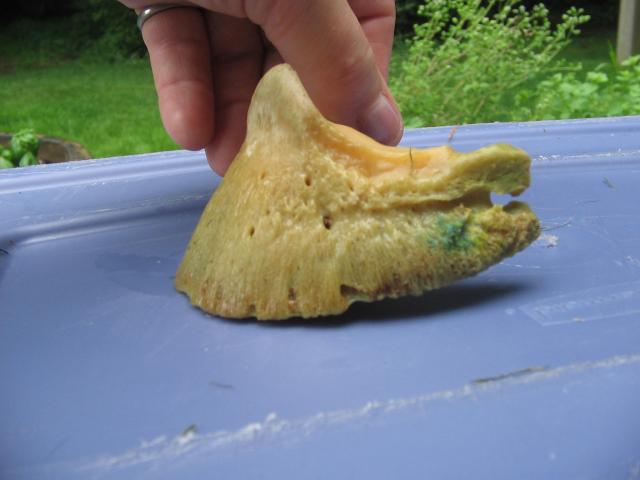
In the first photo you see a hoof capsule that I cooked down on my outside grill. The primary goal of trimming is to encourage the hoof capsule to grow a strong, protective enclosure for the coffin bone and soft tissue structures(cooked off) which are located in the back of the foot.
Inside the capsule you can still see remnants of the laminae. The coffin bone also had laminae on the surface and the two lamina were connected. See how the coffin bone sits in the capsule. The lateral cartilages are soft tissue structures on either side of the back of the coffin bone; they cooked off. The digital cushion, also gone, was located in the back center of the foot, over the frog. Dr. Robert Bowker has likened soft tissue structures of the hoof to the excellent, gel padding found in running shoes. One of the jobs of the soft tissue structures is to absorb shock.
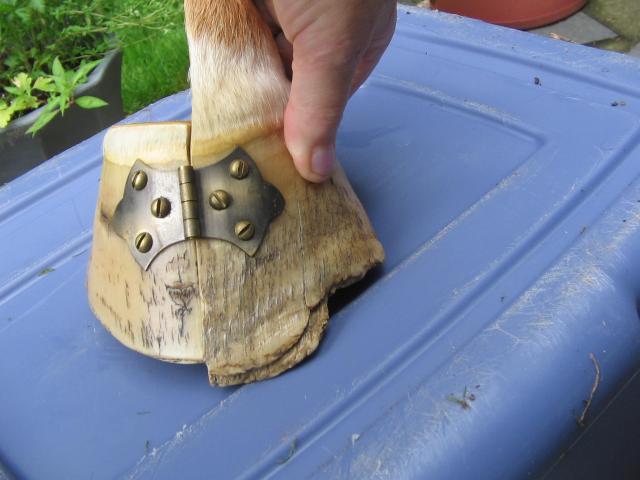
In step one of a foot assessment, I run my fingers down the hoof wall, feeling the angle of growth as seen in this photo with my first model from Allie Hayes, of Horse Science. I call her ‘Honey Bunny’, a wonderful horse who gave her life to educate us bipeds. In most traditionally cared for horses, the first inch or so of wall growth is the angle the horse would like; the rest of the foot is what he is stuck with. If shod, plastic shoes included, the poor horse is cast with no hope of growing a good foot. Jaime Jackson calls this good, top connection, the healing angle. With the correct trim and diet, the healing angle grows to the ground within 7-12 months. Let’s take a look at the hooves of three horses:
- Sunny, Off the Track Thoroughbred
- Eddie, Quarter Horse Cross
- Daniel, Percheron
Love “Sunny” Days, Off the Track Racehorse
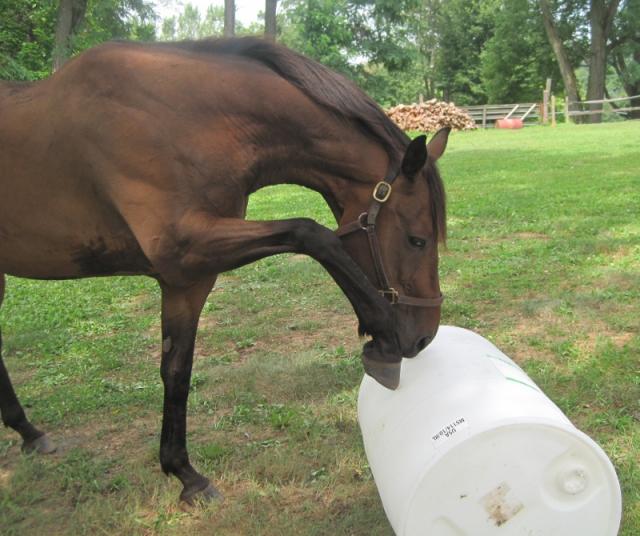
Sunny (a clicker trained horse), now 12, is my Off The Track Thoroughbred; I rescued him as a rising 6 year old. I gave him a year off to be a horse on full turnout with a small herd in Unionville, Pa. and revisited his ground training. Rebacked as a 6 year old, he immediately came up lame in a sand ring. What a surprise that was. It took another year to rehabilitate his partially torn, high suspensory.
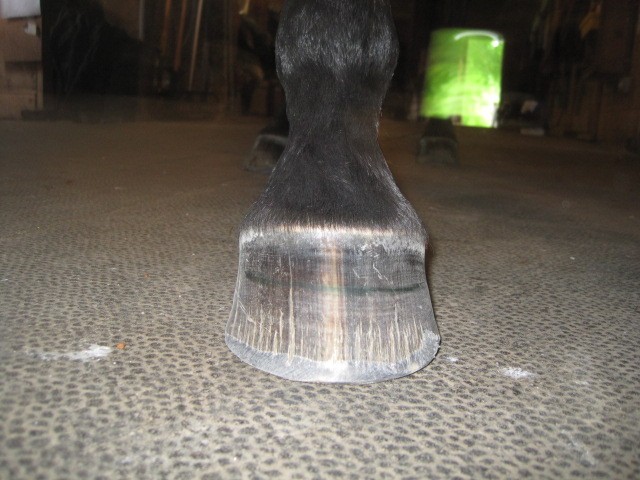
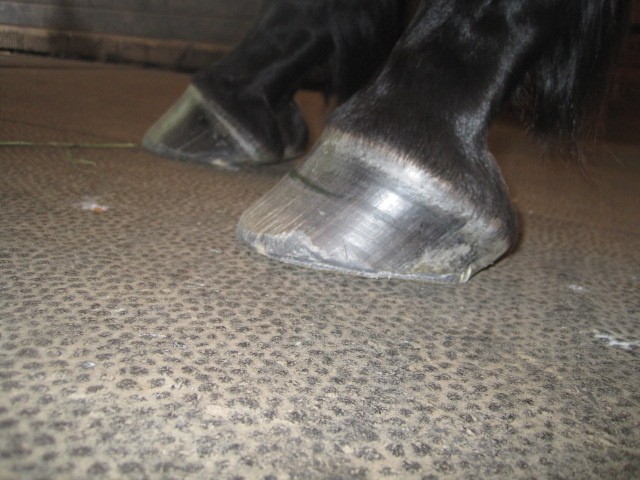
Above, here we are in June, 2011, at the tail-end of our spring, high-sugar grass season. On the front view, from the hairline to the black, horizontal marker line is the healing angle, the hoof Sunny wants. Below the black line is flared hoof wall where the lamellar connection between hoof wall and coffin bone broke, a sign of laminitis due to spring grass. Spring shots may have also played a part.
It is my habit to sharply (60 degrees or so) bevel or angle the outer (dark) and inner wall (bright white) from April 1st to July 1st in an effort to avoid flare. This is called the rehabilitation trim. Although he became gimpy on the gravel driveway this spring, he was rock solid sound when trotting down hills, mounted or unmounted. If he is happy to slam his 1,000 lbs on the back of his feet, on a grassy down hill, I am happy too.
Before evaluating Sunny’s hoof, I would like to discuss some terms. In this solar view below, notice the perimeter of dark outer wall. On a white hoof the outer wall is an egg shell color. Inside his outer wall is the inner wall or water line. Most farriers don’t talk about the inner wall. When I first started I confused it with the white line. The inner wall is always bright white, regardless of hoof color. Go in one more time and that is the laminae or white line; it’s actually off white and often, if you look closely, you can see what looks like scales or leaflets. With a big flare the laminae often pulls apart at the ground level and you can really see the disconnection. A healthy laminae or white line is very thin and tight. Next of course is the sole, then the frog. A healthy foot has a concave sole. Another wall, the bars are on either side of the frog. They begin at the heel and slope gently to mid frog.
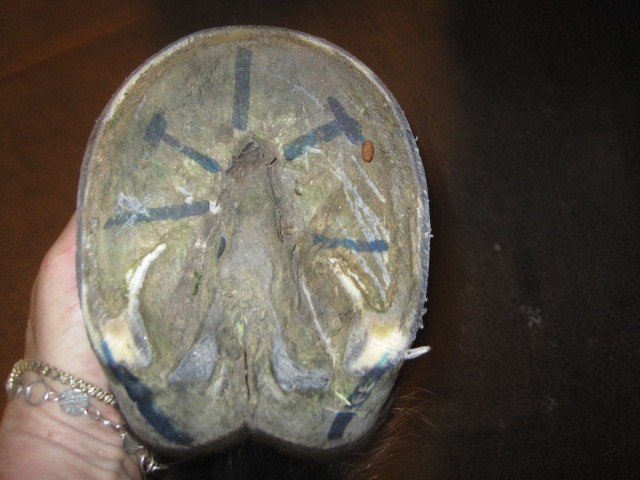
“So how do these feet look?”
- In the first photos, the hoof has a nice cone shape. Good feet come in a variety of shapes, some cone and some more upright. The outer surface is smooth showing no laminitic rings. There are some superficial, vertical cracks along the bottom of the wall created by a response to changes in the environment: wet, dry, wet. In the (hopefully) dry months of July and August, the wall will look like smooth gray granite. Even healthy hooves are on a continuum if your weather and ground vary.
- As noted, he has flare (disconnected laminae) in the lower portion of his foot. Because of this flare, I would expect some loss of concavity on the bottom, sole view. As an aside, when I am helping a horse grow his first well-connected wall, I have noticed that concavity of the sole will start to form when about 2/3’s of the hoof wall has the correct, healing angle.
- When viewed from the side, Sunny’s hair line slopes down, telling me his coffin bone is well placed. The hairline angle may vary a bit depending on his hoof continuum. I do not force any particular angle. However, a horizontal hairline, which we will see in a moment on Eddie, tells me the horse is incorrectly walking on the front of his coffin bone. According to Pete Ramey’s research, the coffin bone in an excellent hoof is within the range of 4 to 11 degrees off the ground in the back. (See the photo where I am holding the coffin bone off ground parallel above.) Ground parallel is not correct. You can only see these angles on radio graphs but I have found that if you just do the natural trim, your horse will find what is right for him. As for evaluation, just look for a downward sloping hairline on the side.
- On the sole view, I have marked his uneven concavity which I expected. Whenever the laminae loses substantial connection: (A) the hoof capsule is too far up the leg and (B) the coffin bone, always under the horse, is too close to the ground. How all this occurs and what actually happens is a heated topic of debate that you can research elsewhere. Again, as I do the trim, the perfect connection will grow in and full concavity will appear. No worries.
- I also marked, on the sole view, the open angle of his heels at the back of the foot. That is another sign of a good foot. The heels are decontracted. Contracted heels on the other hand, point towards the toe or even angle in; I have seen hooves where the heels actually touch! In effect the horse created the additional structure he needed, almost like a natural bar shoe, in order to protect his unhealthy frog and weak back-of-foot. (Remember our shock absorbers: two lateral cartilages and one digital cushion per foot.) As the frog and internal structures improve, most horses grow excellent, decontracted, short heels. Heels should not be forced apart with an ‘opening cut’ because the horse will then land on undeveloped or unhealthy structures. Ouch!
- The frog’s central sulcas, in the center back of his foot, is on the mend. I will treat it daily until it is a thumbprint. I treat until it looks healthy. Don’t stop just when it stops hurting.
The Before Story: Thin, Shelly, Racehorse Feet are created by people and are not congenital.

- Notice the perimeter of the hoof wall. As soon as it hits the ground, the paper thin wall chips. Compare this to Sunny’s June feet. It does take several hoof capsule growths for a horse to develop correct wall and sole thickness. Lots of movement really helps.
- Sorry I don’t have a sole photo. They were flat and thin. The frogs were pencil-thin and unhealthy. When viewing the foot from the bottom, the outer (dark) wall and inner (bright white) wall were so thin that in areas, one or the other would disappear.
- That white band you see coming out of the hairline is just the periople and is perfectly normal. When wet it often appears bright white. I have seen draft horses with the periople running half way down the wall.
- When I first ran my fingers down his front walls, I noticed that they actually angled in, ‘inside the vertical’ and then flared out. My guess is that due to the suspensory tear behind the right knee, the farrier over-trimmed Sunny’s hooves and put him in small shoes to relieve pressure when raced. Of course this was in lieu of rehabbing him. The shoeing job forced the foot to grow in an ice cream cone shape!
- Below are 4 butt cracks signifying thrushy feet. If your horse’s feet touch wet ground or manure, consider investigating and cleaning the foot daily. Treat unhealthy frogs. No frog, no foot. The Horse’s Hoof has a great series on frogs. Thanks to that series, I am much better at frog care.

Eddie, Quarter Horse Cross
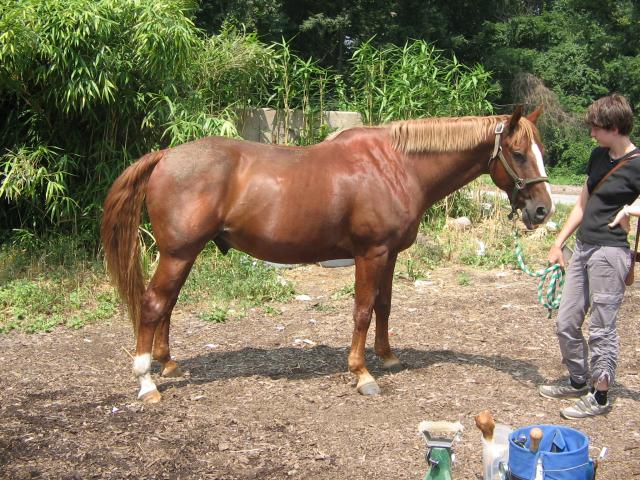
Eddie is turned out for 18 hours a day and ridden every day in an arena or on trails. He is 17 and is trimmed by his owner who now trims professionally in my area. His diet is primarily forage. When his owner began the rehab process, she trailed out in padded Epic boots but now is using unpadded Gloves. He requires no protection when working on grass.
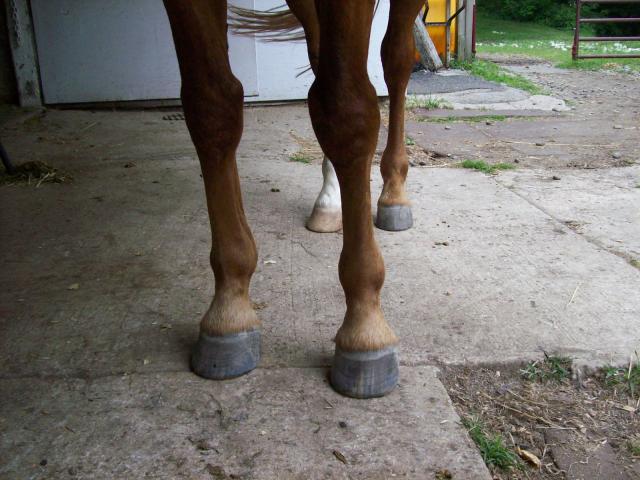
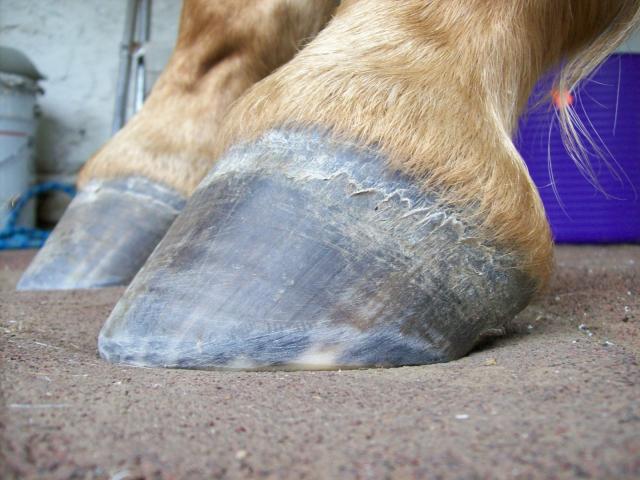
“So how do these feet look?”
- They all have a nice cone shape. His toes are short, just where he wants them. (Not based on a formula, in other words.) There is no noticeable flare. We are still in our spring grass season so it’s not surprising to see a few laminitic rings.
- From the side view you can really see the mustang roll that is critical to a good trim. If you trim the bottom flat, as in the ‘pasture or farrier trim’, you will never grow a well connected foot without flare. ‘The Mustang Roll’ is created by rasping the wall from the bottom at an angle; then trimming the wall from the top at an angle; finally by running your rasp around the edge, you round the entire perimeter, from heel to heel. It’s amazing how this simple process relieves mechanical stress and allows the wall to grow out perfectly, well connected to the coffin bone.
- The front side view appears a bit ‘bull nose’; I would check the heel height and just make sure they aren’t too low. (Range 1/16″ – 1/2″over the exfoliated sole if the frogs are healthy. To find the exfoliated or ‘live sole plane’, just scrape your hoof pick on the sole. The old stuff will scratch off, in most cases.)
- Notice from hairline to ground, Eddie’s short heels, as viewed from the outside. If he were to move to the desert they might become even shorter, as would the toes. His soles might thicken in response to movement on hard, dry ground. His capsule might move down the leg a nick and on radio graph you would see the coffin bone sitting higher in the capsule, just as we see in the mustangs of the western U.S. I mention this because often we owners don’t see hooves in climates dramatically different from our own. Again this is part of the healthy hoof continuum.
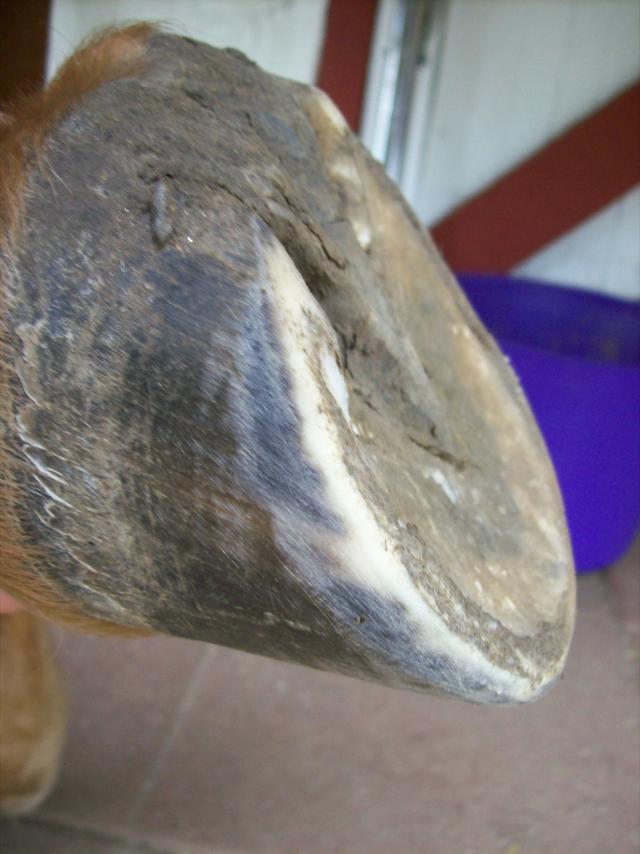
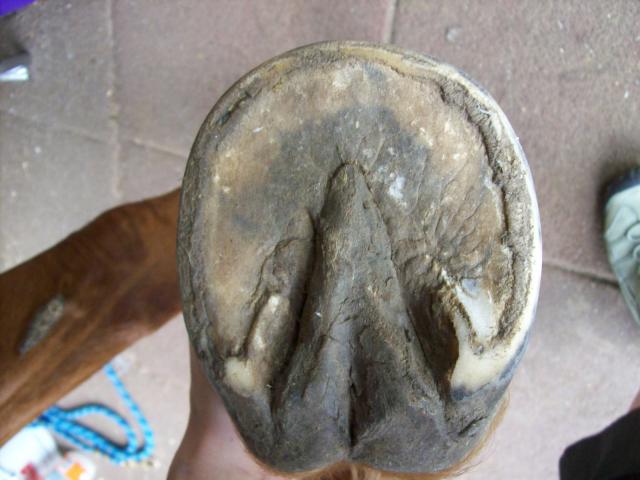
3. In the side or lateral view of the sole, you might notice that in some parts, only the outer dark wall has a 45 degree angle or bevel on it. Because Eddie has no flare, his owner has applied a maintenance trim. She is allowing the inner, bright white wall to grow a nick over the sole. Typically Eddie wears down the inner wall at the toe. Giving the sole just that tiny bit more concavity which travels from the frog to the laminae and then up to the top of the inner wall can greatly improve barefoot performance according to Pete Ramey. It certainly is what we observe in the wild. Please see below, where there’s a ‘maintenance’ self-trim on my hoof specimen from the desert in Australia.
4. In the second photo, I notice what a nice round shape Eddie’s foot has. The cracks on the right side of the sole tell me that he plans to exfoliate it himself. No need to trim his sole; let him do it.
5, The lumpy line on the right perimeter of the hoof is actually laminae, ‘extruded laminae’. The foot probably got wet at one point, then dried and a part of the laminae or white line was squished up. It is completely cosmetic and harmless. Let Eddie wear it off.
6. The central sulcas is located in the rear middle of the frog. It should like just like Eddie’s, a thumb print. When cleaning the foot, daily if your horse lives in any moisture or manure, make sure that area is not sensitive to the hoof pick or any hand pressure. 900 lb Eddie can canter down hill on those babies. Healthy frogs are grown and except for nipping off a tag or perhaps a flap covering an indent that might become infected, I do not routinely trim them. They want to be callused. If sensitive, treat. Again check out The Horse’s Hoof series.
Here’s the hoof of a feral Brumby from Australia. Notice the “maintenance” trim, the beveling of just the outer wall.
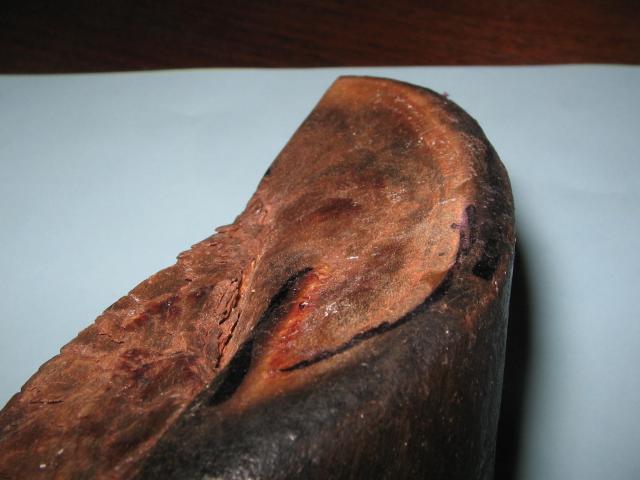
Let’s have a look at Eddie’s before shots.

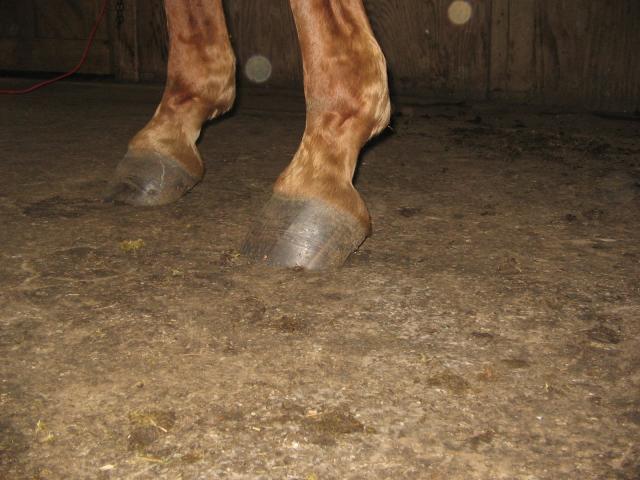
- Once your eyes have seen a few rehabbed feet, you will immediately gasp at these long toes and may even faint when you see heels the long. Poor Eddie is walking on the front of his coffin bone.
- See how horizontal the side hairline is? Ouch! The coffin bone within the capsule is standing on it’s toe. Dr. Bowker has said that you will find remodeled (worn down) coffin bones in most domestic horses. Instead of a nice smooth edge, Eddie’s coffin bone is most certainly ‘moth eaten’, just like the majority of our domestic horses. See the bumpy perimeter of my coffin bone in the beginning of this post.
- On the side of Eddie’s left front foot can you see the bulge above his hairline. It begins about one third back from the front, and continues to the back, over the heel bulbs. Internally that is the lateral cartilage that is being shoved up the leg by the incorrect structure of the foot.
And the view from the sole:
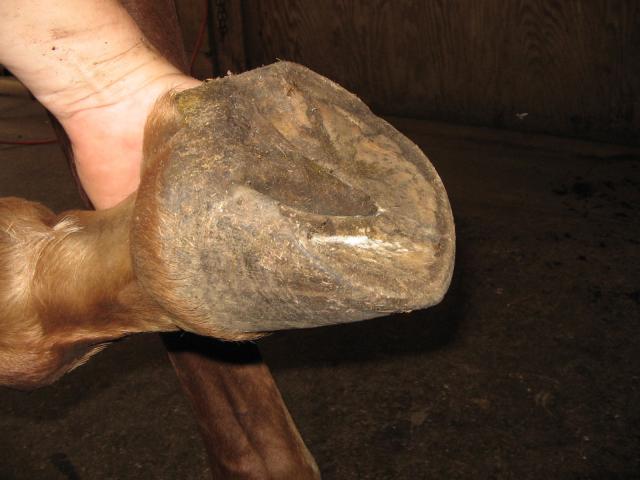

- He appears to have full concavity which is great. I love the round shape that is often the sign of a horse who hasn’t spent much time in shoes.
- Eddie is trimming his own toe back to where he wants it. (Toe at 12:00 to 2:00) Some people will see that and immediately call for shoes thinking that he might wear down his whole foot! No, he is just attempting to self trim into something he can walk on.
- Heels take some discussion.
- From the side view, when Eddie was standing, the heels were definitely long; the horitzontal hairline is a dead give-away. Looking at the heels from the sole view, they are also standing too far over the sole. 1/16″ to 1/2″ is the norm, if the frog is healthy.
- Also check out, from the sole view, the length of heel from hairline to the actual heel he stands on; it is also long. The good news is that he has a healthy frog so we can confidently rasp his heels down and back where they belong. I wouldn’t lower them more than 1/2″ on one visit.
- But what if his frogs were thrushy? I would leave enough heel to protect them then rigorously treat the frog. Forget about heel height; it will come along as frogs rehab.
- Make sure the horse can walk off sound. Never trim a horse lame. That’s nuts in my view.
- Just as the coffin bone can be too close to the ground, so too the lateral cartilages and digital cushion, back-of-foot. When this happens, a lot of rehab has to happens as the heels grow towards what Eddie wants.
- Take a minute to compare Eddie’s before and after photos. During the transition, Eddie never took a bad step. As in all things related to Equus, the time it takes is the time it takes.
- The bars are another hoof wall. They begin at the heels and slope down towards mid frog. If the bars stand over the outer wall, I trim to the correct height, a bit over sole. Please don’t excavate into the sole. When bars become too long, they may dig into the ground or ‘lay over’. According to Dr. Bowker, they do not ‘impact’ or press deeply up into the foot. His conclusions are based on thousands of dissections.
- Eddie also has ‘sole ridge’ that is located next to the frog, on the sole. It begins where the bar ends, at mid frog and runs the length of his frog, on the right side. I scrapped the sole next to it so you could see the ridge more clearly. On some horses, it can run around the entire frog, on the sole, from the end of each bar. This hoof created more structure because it is needed. If the ridge is still there after 3 months, I may begin to trim it, however normally it exfoliates on its own. I have never seen sole ridge on a good foot. Pete Ramey used to trim the sole ridge in his book, Making Natural Hoof Care Work for You, but over time has stopped the practice because he made too many horses tender as noted in his book-update article, Making Natural Hoof Care Work.
Daniel, Percheron

Daniel started life with the Amish and for 8 years worked a farm in Lancaster, Pa. He remained a stallion, thus that glorious neck, before transitioning to a dressage gelding used for teaching. One of his students bought him and took over the care of his hugely flared feet, complete with a matching crack. Now he is part of a primarily OTTB herd (don’t tell him he isn’t a racehorse), on full turnout and ridden a few times a week, lightly. He is in his early 20’s. He never wore boots.
Below, here is where we started. Somewhere along the line, Danny injured his coronary band. Then, unrelated to the injury, huge flare was allowed to developed. Finally the outer wall cracked in response to the mechanical stress of the flare and deformed wall. The crack had been with Daniel since his Amish days.
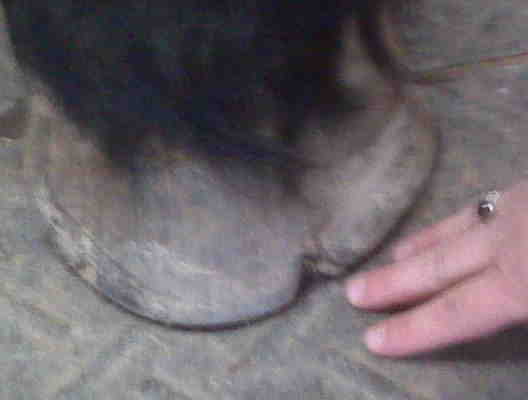
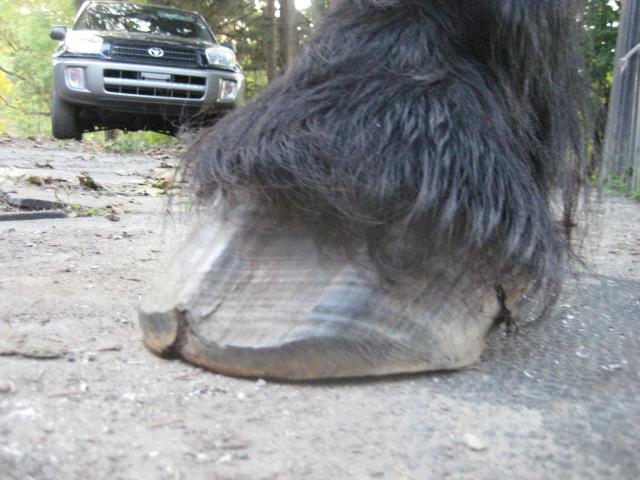
And below, Just beautiful! The damage to the coronary band, although still present, is less evident in the wall when the correct hoof capsule is grown. How long does it take? As long as it takes. Growing out cracks is straight forward. Shoes make cracks worse and do not ‘hold the foot together’ as I have been told countless times.

There is a widespread but incorrect belief that big horses need big, flared feet. When you look at severely flared draft hooves, from the sole view, they will look triangular with points at the toe and on either side. As always, with correct and patient natural trimming, the feet come around. They’re still big feet! If you have a draft horse, you might be interested in Pete Ramey’s latest That’s My Horse: Drafts.
Below, look at the width of the back of the frog! Now that’s a central sulcas shaped like a thumb print. Talk about decontracted, healthy heels. Danny’s owner couldn’t have done it without her Hoof Jack! Can you imagine holding this big guy’s foot for a trim?
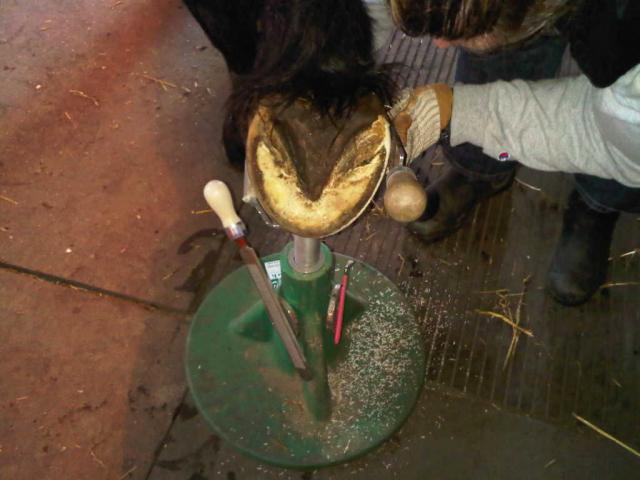
In conclusion, rehabilitation of the equine foot occurs at each horse’s pace and is heavily dependent on:
- The diet,
- The environment,
- Movement and
- The trim, in that order.
Please remember that even exceptional feet exist on a continuum.
On occasion your pony may get a laminitic ring or a quarter crack or a chip in the wall or an abscess. Be patient yet knowledgeable with her rehabilitation and always do the best you can. As long as your horse is sound, in good weight and has a shiny coat, life is good.
I hope I have given you some useful information to assist you in the evaluation of your own horse’s hooves.
Next month I will post a pictorial discussion of many common ‘oddities’ you might see in barefeet that are: just out of shoes or poorly trimmed or good feet having a bad day.
Until then, see you on the trail!
Here are some resources that you might be interested in
For a more in depth understanding of the hoof and how it all works here is a small sample of resources:
- The DVD set Under the Horse by Pete Ramey
- Clinics with Dr. Robert Bowker
- Courses with the Equine Science Academy
- Whole Horse Symposium in Missouri on October 15-17 Dr. Bowker and Dr. Tomas Teskey among many others, will be presenting. This is a priceless opportunity to talk to the best and brightest.
- I have free, basic trimming videos for applying the rehabilitation trim on my site at 4sweetfeet.com
- The Horse’s Hoof. Note that all trims are represented, not just the natural trim based on the wild horse model. Personally I don’t agree with the more invasive trims. It’s a nice resource though and worth reading with a critical eye.




